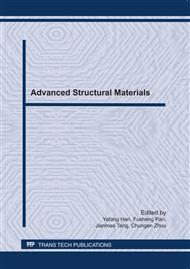p.646
p.654
p.661
p.671
p.678
p.686
p.692
p.696
p.706
The Investigation of the Zirconium Silicate Coatings Prepared by APS
Abstract:
The zirconium silicate can be deposited as functional coatings which will be used at high temperature because of its high melting point and low thermal conductivity. It can also prevent the oxygen of the environment through the coatings and react with the substrate. In this paper, plasma spraying technology was selected to prepare the coatings of zirconium silicate. The orthogonal design method was used to optimize the parameter of plasma spraying process. The content of zirconium silicate in the coatings was checked by XRD because of the decomposition of the zirconium silicate at 1711K.The bond strength and porosity of the coatings were also measured after the optimizing of the plasma spraying parameters in this paper. According the impact on the porosity, the factors of the process can be ordered as follows: spraying distance, current, primary gases and secondary gases. And the order of spraying factors according the impact on the content of zirconium silicate in the coatings was showed as follows: spraying distance, secondary gas, primary gas and current.
Info:
Periodical:
Pages:
678-685
Citation:
Online since:
June 2011
Authors:
Price:
Сopyright:
© 2011 Trans Tech Publications Ltd. All Rights Reserved
Share:
Citation:


